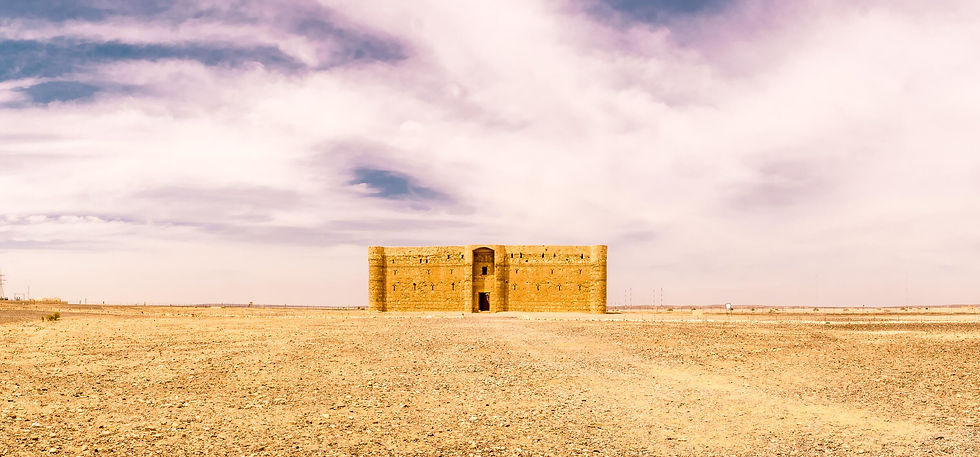
Desert Castles
Al Kharranah Castle
Qusayr Amra
Qasr Al Azraq
Qasr Al Halabat
Hammam Al Sarah
ITINERARY
Kharranah Castle
Pickup from Amman and drive around a 100kms Northeast to Al Kharranah Castle, this imposing and well preserved Umayyad building in the vastness of the Jordanian desert can be dated before 710 AD, due to an Arabic inscription above one of the doors of a room.
Qusayr Amra
Then proceed 16kms Northwest to Amra Palace which was probably built between 730 - 740 AD, commissioned by Prince Walid Ibn Yazid, the future Umayyad caliph Walid II (who reigned only 743-744). Located beside the Wadi Butum, a seasonal watercourse, this desert establishment was both a fortress with a garrison and a residence/pleasure palace that comprises a reception hall and hammam.
Qasr Al Azraq
Continue 30km east to Qasr Al Azraq, the black basalt fort, strategically located in the middle of the Azraq oasis, and on a major desert trade route, has been in continuous use since it was built by the Romans in the 3rd century AD.
The Umayyad caliph Walid II transformed it into his favorite hunting residence in a time when the wetlands nearby offered an extraordinary rich wild fauna. The mosque in the courtyard, the well and the stables are from this period.
Qasr Al Hallabat
The complex of Qasr al-Hallabat is located in Jordan's eastern desert. Originally a Roman fortress constructed under Emperor Caracalla to protect its inhabitants from Bedouin tribes, this site dates to the second and third century AD, although there is trace evidence of Nabatean presence at the site. It was one fort of many on the Roman highway, Via Nova Traiana, a route that connected Damascus to Aqaba by way of Petra and Amman. However, by the eighth century, the Umayyad caliph Hisham ordered for the Roman structures to be demolished in order to redevelop this military site and its neighboring territory to become one of the grandest of all Umayyad desert complexes.
Hammam al-Sarah
Proceed to Hammam al-Sarah in order to expand and consolidate their domination in the region, the Umayyad caliphs cultivated a strategy of political representation where art and architecture played an important role. In their bath-house ensembles, they combined the functional and social value of bathing practices with their political interests, using them as a venue for audiences and receptions for local tribal leaders, seeking their political and military support.
After Hammam al-Sarrah return to Amman for drop off back to your hotel.

Tour Includes
-
Transfers as per above itinerary in a private modern air-conditioned large sized car with English speaking driver.
-
Car has complimentary Wi-Fi and mineral water.
-
Hotel pickup and drop-off from Amman city
Not Included in Tour
-
Local tour guides
-
Entry fees to sites.
-
Meals
-
Tip to driver (good gesture)
-
Extra charges will apply for Pick up or Drop off from elsewhere other than Amman City.
-
Confirmation will be received at time of booking
-
A moderate amount of walking is involved so wear proper shoes (Sneakers or boots are good).
-
You may purchase Jordan Pass before your arrival to Jordan if you are spending more than 3 nights in Jordan, which will wave out visa entry fees and includes 41 sites in Jordan. You may visit www.Jordanpass.jo for more details.
Additional Info
Cancellation Policy
-
You can cancel up to 48 hours in advance of the experience for a full refund.
-
If you cancel less than 48 hours before the experience’s start time, the amount you paid will not be refunded.

